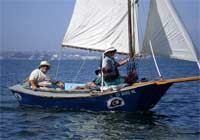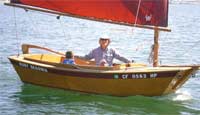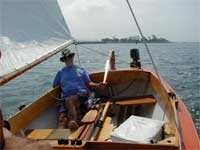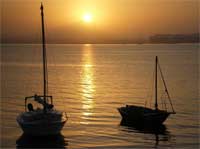Some people call it “the
ugliest boat afloat”. Others
call it the safest twelve-foot sailboat ever designed.
What is it?
Read on.
Bill Short spent 28 years as a tugboat
captain on San Francisco Bay and he was familiar with
its rough waters and tricky summer winds. An avid
recreational sailor and boat designer, he wanted a
boat that hadn’t been invented yet – a
heavy weather sailing dinghy capable of crossing the
notoriously treacherous Golden Gate. It had to be
roomy and comfortable for extra crew and family members
and it had to be safe for a single-handed sailor.
With these and other requirements in mind, Captain
Short went to work. What he came up with was a plywood
sailing dinghy that was a unique departure in both
hull design and sail plan.
 |
The Baywood
Navy's Aluminum Pelican at the 2007 Scuzbums
Giant Five Day Messabout in San Diego.
Click images
to enlarge |
One of Bill’s influences was
the design of the Liberdade, built by Captain
Joshua Slocum in 1887. Captain Slocum and his family
sailed from Brazil to the United States in this boat,
described by the captain as “part Cape Ann dory
and part Japanese sampan”. The ability of the
Liberdade to stay on top of steep seas was
helped by her immense flare and deck level beam. Bill
also considered the design of the scows and other
native working boats that he had seen and sailed during
his WWII stint in the Orient. All of these boats shared
three characteristics: a lug rig, a sampan bow and
ample freeboard. From all of these sources came the
inspiration for San Francisco Pelican #1, the Chloe
Maru, launched in 1959.
Here is what Bill Short
wrote in Building the San Francisco Pelican:
San Francisco
Bay’s main ship channel is a very rough and
windy arm of the sea. It has a well-earned reputation
for its strong west winds and choppy waters. Waters
which most small centerboard sailboats carefully
avoid. This challenge was met by the San Francisco
Pelican… The sampan bow proved to be buoyant
and broachproof, and her generous freeboard and
flare proved to be real insurance against swamping.
It is a dinghy
for heavy weather and yet a handy, fast centerboarder.
The Pelican
has…demonstrated that a twelve-foot non-ballasted
centerboard sailboat CAN cross these waters through
the roughest chop and stand up to the strong Summer
afternoon winds.
Vital Statistics
Length overall |
- |
12 ft. 2.5 in. |
Beam |
- |
6 ft. 1.75 in. |
Draft, board up |
- |
4 in. |
Freeboard amidships |
- |
2 ft. |
Minimum racing weight |
- |
390 lbs. |
Sail area, main |
- |
72 sq. ft. |
Sail area, jib |
- |
33 sq. ft. |
A HEAVY WEATHER
DINGHY
The Pelican has been
described as looking like a floating bathtub. Someone
even called it “the ugliest boat afloat”.
Ungainly it may be, but its very ungainliness is its
prime virtue. Its unique flat bow is a major factor
in preventing burying and broaching when running before
the wind in a swell and its flaring topsides give
the boat extremely effective righting leverage. Even
the single-handed sailor can shift his head and shoulders
to windward in order to keep the boat on an even keel.
Its generous flare and freeboard are more insurance
against swamping.
As what Bill Short
referred to “a nautical rabbit’s foot”,
the Pelican is designed to carry extra buoyancy in
the form of styrofoam blocks, installed on the starboard
side only. The styrofoam, together with the wide beam
and high, flaring sides, provides the capacity for
self-righting. As experienced Pelican owners like
to boast, the boat can be turned over, but it isn’t
easy. Some Pelican fleets offer a Turtle Award to
skippers who manage to capsize or swamp their boats.
 |
Gorden Bundy
and grandson Cole aboard the Pelican "RUBY
BEGONIA" |
Granted, the San Francisco
Pelican doesn’t sail well to weather and it
cruises at only 3 to four knots, but it’s a
stout little boat with a loyal (and growing) following.
The Pelican is an
ideal boat for Junior Sailing programs. The boat is
certainly safe for beginning sailors and while it’s
an easy boat to learn on, learning to sail it well
takes practice.
BUILDING THE
SAN FRANCISCO PELICAN
Bill Short didn’t
build the first Pelican with the intention of selling
the plans, but in the months following her launching,
the Chloe Maru began to attract attention due to her
“ugly duckling” charm and remarkable seaworthiness.
An article in a San Francisco newspaper generated
even more interest and soon Captain Bill began receiving
requests for building instructions. In 1960, Rudder
magazine published a letter from Bill and a photo
of the Chloe Maru and in 1963, a three-page article
about the boat.
Bill and his wife
Muriel began reproducing the plans for the Chloe Maru
and providing them to amateur boatbuilders. The early
plans were workable but fairly crude, until a retired
marine insurance adjuster became interested in the
boat and worked with Bill to create step-by-step building
instructions and more accurate drawings.
Monoque design concepts
make the hull strong, light and roomy with a minimum
of internal bracing. Its construction is all 3/8”
plywood with the exception of the transoms, centerboard
and rudder, which are 3/4” plywood. Bill assured
amateur boatbuilders that if they possessed basic
carpentry skills and could read a table of offsets,
they would have no problem following the drawings
and plans. According to an article in Good Old Boat
magazine, it’s estimated that over 10,000 sets
of plans have been sold worldwide. Bill died in 1986;
Muriel Short still sells the plans, complete with
instructions for constructing a jig. Once the first
hull is built, the jig can be used to make additional
hulls, making the Pelican a good design for club sailing.
In addition to the
scratch-built boat, the Pelican is available as a
kit - either a basic bare hull or the bare hull with
all the major components cut out and rough-shaped,
ready to be finished. The hull and deck kit costs
approximately $1500, while a finished boat complete
with sails, running gear and trailer can be purchased
for around $6000. Several boatbuilders in the Pacific
Northwest specialize in Pelicans; alternatively, second-hand
boats in reasonable condition can be had for under
$2000. Just add water!
Over the years, the
basic design of the San Francisco Pelican has remained
essentially unchanged; within the specifications,
however, there is plenty of opportunity for customization.
Most home-built boats have personal touches added
by their owners, including oarlocks, boom tents and
other amenities. Built-in storage compartments and
boxes for camping equipment are popular; it’s
even rumored that one Pelicaneer added a fiberglass
foam-lined built-in beer cooler. A small outboard
motor can be mounted on an adjustable bracket on the
transom for use when the wind dies or the tide changes.
 |
"Miwok",
a Pelican 12 |
CRUISING WITH
THE PELICAN
Bill Short designed
the Pelican to be a family cruising boat, as well
as a class racing boat. The Pelican’s light
weight makes it easily trailerable and it can be stored
in the front yard between excursions. It can tow a
single-person kayak, which can be pressed into service
as a dinghy, and the capacious storage space easily
holds all the camping gear the well-equipped Pelican
cruiser might need, including a tent, sleeping bags,
cooking equipment, food and clothing. Even loaded
with half a ton of people and gear, the dory bottom
allows the Pelican to float in four inches of water.
Bill Paleck, a local Pelicaneer, says this: “Pelicans
can pack a load. I know for a fact that the fully
loaded bed of a Ford pickup, my wife and our dog can
fit into a Pelican and still have enough freeboard
and space to sail her to our destination.” Not
bad for a twelve-foot boat!
The Pelican is also
perfect for the single-handed sailor who wants to
cruise the islands and stop for a nap along the way.
As an example of extreme cruising, a Pelican sailor
named Tom Shives spent two weeks last summer sailing
solo from Bellingham to Olympia in his Pelican, a
distance of 120 miles without a motor. He slept onboard
or camped on the beach – a trip recommended
for only the hardiest Pelicaneer!
RACING THE
PELICAN
The Pelican is a handy
one-design racing dinghy for a skipper and one crew
member; sailors of all ages and physical abilities
can handle the boat. Crewmembers don’t need
bulging muscles to tend the sheets or six-pack abs
for hiking out. Parents or grandparents can pair up
with kids or grandkids. Many spouses race together
and are still speaking afterwards. The Pelican certainly
won’t keep up with the high tech planing dinghies,
nor is it meant to. It does, however, take skill and
practice to get top performance out of the hull and
rig. It’s an economical boat to own, easily
rigged and unrigged and well adapted to most any racing
venue with a launch ramp nearby. It’s a great
boat for small clubs or even a few friends who want
to get together for an informal regatta. The design
and construction materials have not changed over the
years, so older Pelicans are still competitive with
new ones. Most important, there is an active racing
fleet in the Pacific Northwest.
SAN FRANCISCO
PELICAN VIKING FLEET III
Muriel Short estimates
that 6,000 Pelicans are in use today. Many amateur
builders don’t register their boats with the
Pelican Association, so the number could be much higher.
Pelican activities on the West Coast center around
the California and Puget Sound fleets.
The Puget Sound fleet came into being around the time
that Fred and Don Smith, the Pacific Northwest’s
premier Pelican builders, got enough Pelicaneers together
to form a fleet. Don applied for a fleet number and
Viking Fleet III was born. From all reports, those
early Vikings were a rowdy bunch. Things have calmed
down since those days, but not much: the present fleet
sails year-round. Frostbite racing begins in October
and ends with the fleet championships in April. Every
two weeks, hardy Pelicaneers assemble at a different
body of water, salt or fresh, for a series of three
races, winds permitting.
 |
Sunrise at San
Diego |
In addition to racing,
Viking Fleet III cruises all summer. Day cruises and
fun days are popular and a two-week cruise in July
gives local Pelican sailors the chance to meet Pelicaneers
from other parts of the Pacific Northwest. Fred Smith
leads a cruise through the San Juans in August. Short
hops from island to island allow plenty of time for
fishing, crabbing and relaxing on the beach.
In his introduction
to Building the San Francisco Pelican, Bill Short
wrote:
“On any
windy bay, where the waters are choppy and the wind
is swift, you’ll find that the San Francisco
Pelican will achieve a happy accommodation with
the sea that makes her a buoyant craft to behold
– and better to be in!”
If you’d like
more information about Viking Fleet III, please contact
Bob Rodgers, the current Commodore. His email address
is bobrodgers100@hotmail.com.
Muriel Short’s email address is pelicansailboat@webtv.net.
You are also invited to visit the official
SF Pelican website.
For kits or completed
boats, see Ratty's Boatworks - https://rattysboatworks.com/

|